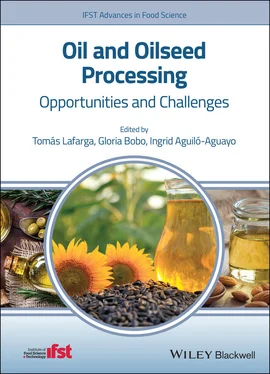Cottonseeds were the fifth most produced commodity within the “processed crops” classification of FAOSTAT, surpassed only by barley, sugar, molasses, and palm oil. World production of cottonseeds was measured as 46.98 Mt in 2014 (UN 2019). Although cottonseed production decreased significantly during the period 2015/2016 to 37.76 Mt, it is now slowly recovering and reached 43.39 Mt produced during the period 2018/2019 (USDA 2019a). Major cottonseed producers were China, India, and the US with a production of 12.32, 12.30, and 4.64 Mt. Cottonseed oil production is largely concentrated in India, the US, Pakistan, and China (FAO 2018). In the EU, cotton is produced only in three Member States on around 300 000 ha, mainly in Greece (approximately 80% of European production), Spain (20%, mainly grown in the region of Andalucía), and Bulgaria that produces cotton on less than 1 ha. Globally, major cottonseed exporters are the US, Greece, Australia, and Brazil with average exports of 182.12, 176.42, 166.96, and 95.45 kt/year. Despite being one of the most produced oilseeds, cottonseed oil production during the period 2018/2019 was reported to be 5.17 Mt, significantly lower than the amount of soybean, rapeseed, palm, or sunflower seed oil, which were 57.07, 27.78, 73.49, and 19.49 Mt during the same period (USDA 2019a).
1.2.3 Groundnuts and Groundnut Oil
Groundnut or peanut ( Arachys hypogaea L.) is one of the most important oilseed crops in the world. Groundnut consumption as well as commercial products containing groundnuts vary in large proportions as peanuts have been developed into a large number of products like roasted peanuts, peanut butter, peanut paste, peanut flour, peanut “milk,” or peanut cheese analogues (Arya et al. 2016). In Western countries, groundnuts are mainly used for direct consumption as salted and roasted nuts. In the US, groundnuts are also utilized for making peanut butter and confectionary. In turn, in China and India groundnuts are primarily crushed for oil production (Pandey et al. 2014).
The cultivation of peanuts, which was originated in South America, has expanded and groundnuts are currently being produced in over 100 countries of Asia, Africa, and the Americas (Pandey et al. 2014). Over 70% of the groundnut growing area comes under arid and semi‐arid regions (Shasidhar et al. 2017). Figure 1.1shows the annual production of groundnuts per country during 2017.
World production during 2017 totaled approximately 47.09 Mt, which represents an 18% increase from the 39.9 Mt produced in 2013 (Torres et al. 2014). World area harvested with groundnuts has also increased over the last decades and is currently over 27.94 Mha. This trend is likely to continue to grow. Major groundnut producers are China, India, and the US with 17.09, 9.18, and 3.28 Mt produced in 2017. The US is one of the biggest groundnut exporters, with 0.36 Mt exported in 2016. Argentina, which was the seventh major producer during 2017, was the third major exporter during that same year with 0.29 Mt of groundnuts exported. Argentina, the US, Sudan, Senegal, and Brazil account for over 71% of total world exports (Torres et al. 2014). Other countries like Vietnam, India, and several African countries periodically enter the world market depending on market demands and their crops quality (Torres et al. 2014). Indeed, in 2016, India was the major exporter with 0.61 Mt of groundnuts exported. Moreover, major groundnut importers in 2017 were the Netherlands, China, Indonesia, and Mexico with 0.32, 0.19, 0.14, and 0.13 Mt respectively. Peanut imports into the EU, Canada, and Japan account for approximately 78% of the world's imports (Torres et al. 2014). Approximately 5.03 Mt of groundnut oil were produced in 2014, mainly in Asia (69.4%), Africa (23.8%), and the Americas (4.5%). The top five peanut oil producers are China, India, Nigeria, Myanmar, and Sudan with an approximate production of 1.87, 1.25, 0.27, 0.21, 0.15 Mt respectively.
Flax ( Linum usitatissimum L.) belonging to the family Lineaceae is a blue flowering herb that produces small flat seeds, which vary from golden yellow to reddish brown and have a nutty flavor (Kajla et al. 2015). Flaxseeds, also known as linseeds, are an economically important oilseed crop used for industrial, food, and feed purposes. Generally the term flaxseed refers to the seed grown for fiber production (linen), while linseed refers to the oilseed grown for industrial and food uses. In the current chapter, both terms will be used indistinctively.
Linseeds are currently being cultivated in more than 50 countries, predominantly in the Northern hemisphere as shown in Figure 1.1. The harvested area in 2017 amounted to 2.78 Mha representing a 14.04% annual increase during the last decade. For example, in the EU, the area harvested increased from 52 000 ha in 2008 to 70 000 ha in 2019, representing an average annual increase of 13.5% (European Commission 2019). World production of linseed increased from 1.98 Mt in 2000 to around 2.79 Mt in 2017. At the beginning of the century, Canada was the world's largest producer and exporter of flax, and represented about 40% of the world's production and 75% of the global flax trade (Oomah 2001). Currently, Canada produces 0.51 Mt of linseed per year and ranks third in the list of top producers, surpassed by Kazakhstan and Russia, which produced 0.68 and 0.61 Mt, respectively. Currently, most of the linseed currently produced is grown in Asia followed by Europe and the Americas, with production shares of 44.7, 28.6, and 22.7%, respectively. Canada is still the biggest linseed exporter, followed by Russia, Kazakhstan, Belgium, and the US. Exports of these countries during 2017 were approximately 0.62, 0.61, 0.27, 0.18, 0.03 Mt, respectively. Major linseed importers were Belgium, China, Turkey, and Germany with 0.58, 0.47, 0.19, and 0.15 Mt of seeds imported during 2017.
Belgium, which imports large amounts of linseeds is one of the world's most important linseed oil producers. In 2014, 0.12 Mt of linseed oil were produced in Belgium, only surpassed by China with an annual production of 0.19 Mt third, fourth, and fifth major linseed oil producers were the US, Turkey, and Germany. Top five linseed oil exporters during 2016 were Belgium, Germany, Turkey, Kazakhstan, and Gambia. In turn, Gambia was the major linseed oil importer followed by China, Germany, the Netherlands, and the UK.
Maize ( Zea mays L.), also known as corn, is a cereal grain from the family Gramineae , which includes plants such as wheat, rice, or sugarcane. Cereal grains are key‐importance crops as they provide humans with more nourishment than any other food class and nearly 50% of the total caloric requirement (Ranum et al. 2014). Maize was first domesticated by indigenous peoples in the mid‐ to low‐land regions of what today is known as Mexico, around 9000 years before present (van Heerwaarden et al. 2011). Today, maize is a staple food in many parts of the world, with the total production of maize surpassing that of other staples including wheat (UN 2019). Table 1.1lists some products recently launched into the market manufactured using maize oil. Production of maize showed an important increase in both area harvested and total production over the last decade. Currently, world area harvested is approximately 197.15 Mha, showing an important increase from 2007 when approximately 158.67 Mha of maize were harvested. World production of maize was 1134.74 Mt in 2017. Maize ranked fifth in the most produced commodities during 2017 according to data accessed from FAOSTAT, only surpassed by “total cereals,” rice, sugar cane, and “total coarse grain.” Approximately 50.9% of the maize produced during 2017 was cultivated in the Americas, followed by Asia and Europe with production shares of 31.9 and 9.7%, respectively. Largest producers were the US, China, Brazil, Argentina, and India with production quantities of 370.96, 259.07, 97.72, 49.47, and 28.72 Mt in 2017. Recently, the USDA predicted lower maize imports and production for 2018/2019. Larger maize exporters during 2016 were the US, Argentina, Brazil, and Ukraine with 55.99, 24.50, 21.87, and 11.01 Mt, respectively. Increased corn exports in Argentina and Ukraine are expected, partially offset by reductions for South Africa and Mexico (USDA 2019b). Japan, Mexico, the Republic of Korea, and Vietnam were the larger importers during this period with approximately 15.34, 14.10, 9.78, and 8.05 Mt, respectively (UN 2019). As a crop, maize is highly productive and versatile, and responded successfully to investments in research, breeding, and promotion. However, the current corn production system can be considered inefficient, at least at feeding people. Only a small fraction of the maize grown over the world is consumed directly by humans. Most of the maize currently harvested today is being indirectly used for human consumption as animal feed or as raw material for the production of maize‐derived products such as corn starch or corn syrup, or used for other industrial purposes such as the production of ethanol. An important part of maize production, approximately 40%, is being used as a raw material for the production of ethanol used as a motor fuel (Ranum et al. 2014). The utilization of maize for producing biofuels has a strong impact on production and trade. Indeed, total corn use was predicted to decrease by 165 M bushels (approximately 4.19 Mt) mainly caused by a 40 M bushel decrease (approximately 1.01 Mt) in the amount of corn used for ethanol production (USDA 2019b).
Читать дальше












